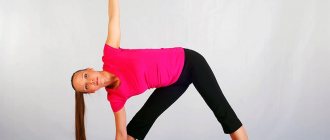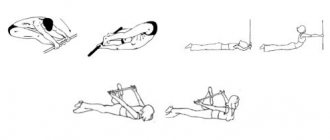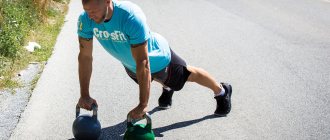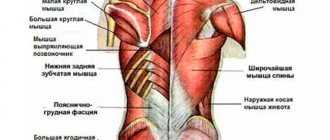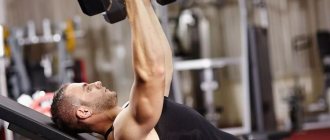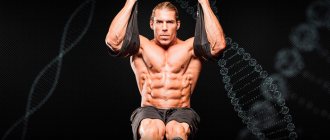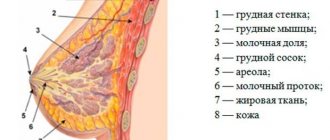Stretching exercises for the muscles of the back, neck, and legs are a mandatory component of any set of exercises. They help relax muscles after running or strength training, but can also be performed as an independent form of physical activity. After all, the ease of gait, beautiful posture, and good health depend on the elasticity of your muscles. Body flexibility is an indicator of the aging of the body. It’s no wonder that stretching, Pilates and yoga are so popular now. You can start stretching at any age; positive results will not be long in coming.
What does spinal stretching do?
The vertebral trunk is the main part of the human skeleton, consisting of vertebrae and the discs between them. Discs are made of cartilage tissue, connect the vertebrae and serve as shock absorbers for their mobility. Spinal extension or traction is a method that helps improve the mobility of the vertebrae and get rid of pain symptoms caused by various factors.
There can be many reasons that cause pain in the spine and its diseases, but the main ones are the following:
- injuries of the spine and vertebrae with or without their displacement;
- age-related changes associated with drying of the intervertebral discs;
- lifestyle associated with sedentary work.
Due to this lifestyle and age-related changes in the human body, metabolic processes are disrupted. As a result, blood vessels are blocked, the elasticity of tendons and ligaments is lost, which leads to poor circulation and diseases of the musculoskeletal system.
Back stretching exercises can help in the following cases:
- for hypertension and cerebrovascular accidents;
- when relieving pain symptoms from intervertebral hernia;
- from fatigue and overstrain after work;
- from scoliosis, stoop and joint problems;
- strengthen your back muscles and improve your posture.
Pros and cons of back stretching
Harm
Some athletes stretch before training, as part of their warm-up. This is not entirely correct, and here's why.
First of all, it should be noted that back stretching exercises negatively affect the athlete’s strength and speed. Perhaps this is the most unobvious fact, so we need to consider it from an anatomical point of view. When working in the gym (no matter what sport), the body activates the muscles. These same muscles consist of fibers that are unchanged in their quantity and can only grow under the influence of loads.
Many muscle fibers make up a dense, taut mass of leverage, due to which the athlete presses and pulls, and shows incredible miracles of strength and endurance. At the same time, stretching the back muscles causes the muscles themselves to stretch and become less tight. From an anatomical point of view, now in order to produce any action, the body must first compress the muscles and then unclench them at peak load. The spring principle works. What happens if the spring is first stretched strongly and then compressed back? Naturally, it will not be possible to obtain the same stiffness coefficient due to severe deformation.
This is why many athletes refuse to stretch their muscles before training, limiting themselves exclusively to warm-up approaches.
But we are talking exclusively about strong stretching (the kind that kickboxers, dancers, etc. do), which increases mobility in the joint. As for small warm-up stretching of the back and gymnastics, they in no way affect athletic performance.
And stretching after strength training or on separate days does not do any harm at all, only benefit.

© Starstuff - stock.adobe.com
Contraindications
The second reason why many athletes refuse stretching is contraindications. Of course, usually their list overlaps with sports, but few people pay attention to this.
Back stretching is not recommended if:
- arthritis;
- osteoporosis;
- pronounced kyphoscoliosis curvature of the spine;
- presence of injuries;
- presence of hernias;
- pregnancy at any stage;
- for other joint diseases.
As you can see, the list is quite large. And if you look carefully, most of the contraindications coincide with contraindications for intense physical activity.

Is it worth it?
Considering the negative factors associated with good back stretching, the question arises: is it worth it or not? If there are no contraindications, stretching after a workout or on a separate day is an excellent activity. She helps:
- relax muscles after strength work;
- remove metabolic waste that was created during training, which will lead to less muscle pain in the following days and you will recover faster;
- increase flexibility, which can also have a positive effect on strength training.
In addition, it improves the condition of the spine (which is especially useful for people with sedentary professions) and improves joint mobility, which is a necessary factor for achieving good results in any strength sport. So the conclusion is clear - for any sports activity, stretching the back is a necessity, not a whim.
Indications
As clinical practice shows, treatment of serious and chronic diseases of the spinal column, such as a hernia between the vertebrae and osteochondrosis using exercise machines, a horizontal bar and an inversion table does not produce significant results. In these cases, stretching the spine with the help of therapeutic exercises comes to the rescue, which should be prescribed to the patient by his attending physician.
Traction or extension of the spine in a clinical setting helps with:
- curvature of the spine (scoliosis, lordosis, kyphosis);
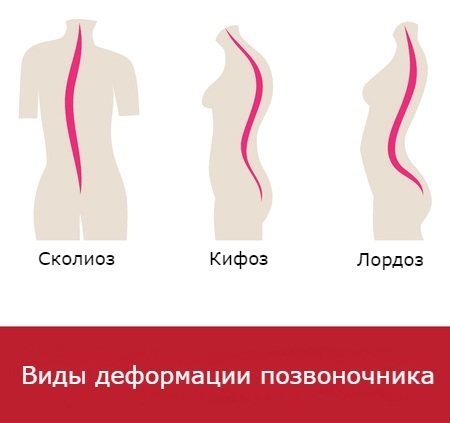
- pinched nerve roots;
- neuralgia and radiculitis;
- lumbodynia, convulsions and ankylosing spondylitis.
| Name of traction, technique | Application (spinal region) | Disease |
| Underwater | Lumbar, thoracic | Radiculitis, lumbodynia, pinched nerves |
| Dry | Cervical, thoracic, lumbar | Scoliosis, lordosis, kyphosis |
| Hardware | Cervical, thoracic, lumbar | Hernia, scoliosis, osteochondrosis |
| Bubnovsky | Lumbar | Radiculitis, hernia, osteochondrosis |
| Şişonina | Cervical, thoracic | Hernia between vertebrae, hypertension, osteochondrosis |
| Manual therapy | Cervical, thoracic, lumbar | Radiculitis, vertebral displacement, hernia |
General rules and recommendations when performing exercises
Stretching the spine at home should be done using a method from simple to complex and, of course, you need to constantly consult and be monitored by a specialist in manual therapy. When doing gymnastics at home, you don’t need to chase the desire to cover a large number of different exercises, but you need to stop at 2-3, but do them regularly.
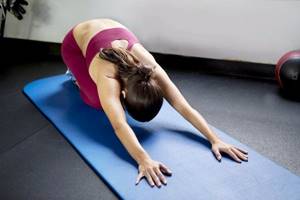
The basic rules will be as follows:
- The main thing is to do the exercises regularly;
- Before the main exercises, it is advisable to do a warm-up;
- make movements smoothly and at a slow rhythm;
- monitor relaxation and avoid overstraining the body;
- breathing should be even and deep, not shallow;
- refrain from performing a set of exercises immediately after eating.
Why do you need stretching?
Each of us feels the benefits of civilization, which deprive us of a sufficient amount of movement. We are sitting at the computer, in a not very comfortable position. You yourself have probably noticed how stiff your neck and shoulder girdle are. We move by transport, public or private. We spend our evenings in front of the TV. And even simple stretching brings relief to the body. And if you do stretching correctly and regularly, then:
- the body will be in good shape;
- recovery processes in the body will improve, as blood flow will accelerate;
- Nervous tension is relieved by stretching and relaxing muscles;
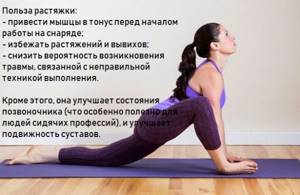
- spine mobility improves;
- Pain in the neck and lower back decreases and goes away.
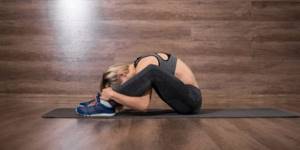
Even 5 to 15 minutes of stretching a day will bring tangible results within a week. And, most importantly, such exercises do not require a gym; you can do them at home yourself at a time convenient for you.
Underwater traction
To stretch the spine in clinical settings, dry, underwater and hardware traction are used. During underwater traction, the patient is placed on a table, which is located in a bath with mineral, hydrogen sulfide, radon, iodine-bromide or ordinary water.
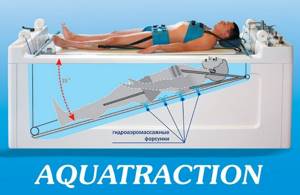
The stretching occurs with the help of two belts, one of which fixes the body to the table, and behind the other the spine is stretched. The tension force depends on the patient’s body weight and other parameters that are set by the doctor, while the patient can optionally turn off the procedure process.
The aquatic environment has a beneficial effect on the muscles and nerves when stretching the spine, and also helps to treat intervertebral discs and radiculitis.
Treatment of diseases by traction of the spine
Traction is indicated for problems with mobility and flexibility of the back. Similar situations include:
- compression changes in the spine;
- fissure of the fibrous ring;
- infringement of the capsule of the intervertebral disc;
- pseudospondylolisthesis (vertebral instability);
- dorsalgia (back pain);
- radiculoneuropathy (nerve compression);
- spinal deformity;
- rachiocampsis;
- acute radicular syndrome;
- deforming arthrosis;
- spondyloarthrosis (restricted mobility of the spine);
- subacute radicular ischemic syndromes;
- spondylosis (growths on the vertebrae);
- neurogenic pain;
- secondary vertebrobvisceralgia (vertebral artery syndrome, cervical syndrome, glenohumeral syndrome, costoclavicular syndrome, scalene muscle syndrome, Meniere's syndrome, secondary vertebrocardialgia, etc.);
- debut of ankylosing spondylitis.
Indications for spinal traction - photo gallery
Spinal traction using hardware or at home occurs strictly under the supervision of professionals, as prescribed by a doctor, and only after preliminary examinations (tests, x-rays, MRI).
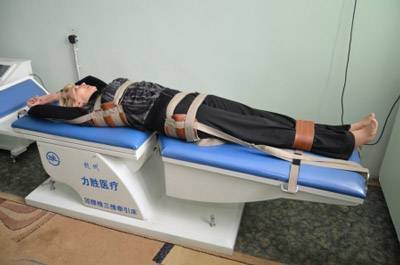
Spinal traction should be performed on a horizontal surface
Underwater traction
Procedures in hydrotherapy baths have a dual effect: firstly, the spinal column is stretched with accompanying healing processes; secondly, heated mineral waters have a positive effect on the patient.
The patient is fastened with special belts to a hard surface, then the patient is immersed in water. Loads are suspended from the belt with a gradual increase in weight, and then with a consistent decrease. Thanks to the tension in the lower back, the natural curvature of the spine is slightly reduced, which helps dull or eliminate radicular pain.

Spinal extension in water eliminates the harmful effects of gravity
Exercise equipment
An inversion table is the base of a swing, on the top crossbar of which a table is attached to position the patient’s body. At the base of the table there are leg clamps. The patient lies down on the table and turns over, adjusting the angle of his body. In this arbitrary, inverted position, a gradual stretching of the spine occurs.
Hanging on a horizontal bar is one of the effective ways to stretch the spine and correct posture. The crossbar is easy to make at home, and it helps to stretch not only the spinal column, but also the muscles of the whole body. To prevent your hands from getting tired, you can fix them on the crossbar with special leather straps.
For older people, the Evminov simulator may be suitable. It is similar to an inversion table, only the board is firmly attached to the wall and there is a crossbar at the top for gripping with your hands.

The patient himself adjusts the angle of raising the board. Holding the bar, he slowly relaxes and stretches the muscles of the spinal ridge. For people in good health, this exercise machine helps to pump up their abs.
The Glisson loop is used to stretch the spine in the neck area. This exercise machine consists of several sewn belts that are fixed under the chin and the back of the head.
Sitting on a chair, the patient puts on a clamp, which is attached to a fixed support from above, and a load is tied to the counterweight, or the patient himself regulates the degree of force with his hand. This simulator copes well with traction of the cervical vertebrae and their diseases.
The structure of the back muscles
Everyone can recognize a person who pumps the back muscles by their figure. A muscular bodybuilder has a back that resembles an inverted triangle. This figure is achieved through regular training of the spinal muscle group. Exercises for the back muscles give good posture.
These muscles are the most powerful; they are involved in almost all physical exercises: pushing, lifting, twisting. Strengthened spinal muscles form an additional protective barrier for the spine. Constant exercises that work your back will help relieve pain in the lumbar region.
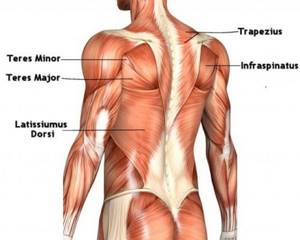
The upper body is mainly composed of muscle fiber. A person does not notice which muscles work during a particular action. But as soon as you strain a certain group of muscle joints a little more, the next day, at the slightest physical action, the body will react with an unpleasant feeling of discomfort due to stretched ligaments.
In order to form a beautiful body, you need to start practicing systematic physical activity on all muscle groups that are located on the back. Beginning athletes are interested in how the back muscles are located and anatomy - the pictures will help you see this in more detail.
The shoulders contain the trapezius, rhomboid major and rhomboid minor muscles. On the forearm there is a deltoid, and in the area of the scapula there are large and small round ones. Along the vertebra there is a muscle that straightens the spine. Below the shoulder blades are the serratus posterior inferior and latissimus dorsalis. In the region of the kidneys there is the external oblique and thoracolumbar. Near the buttocks is the gluteus maximus.
Trapezoid - in the upper back, covering most of it. It is located in the form of 2 trapezoids in a mirror image on 2 sides of the spine. It originates in the cervical region and extends to the center. Stretching the trapezius muscle helps move your shoulder blades.
The rhomboid major and minor muscles, whose shape is similar to the geometric shape of a rhombus. These muscle fibers are located under the trapezius muscle and perform the same functions.
The latissimus major and minor are located in the dorsal region of the shoulder joint and are responsible for raising the arm from the shoulder. The peculiarity of the swing of this ligament is that under load it begins to swell, thereby giving relief and increasing the width of the back.
The muscle that is responsible for straightening the spine is located deep and runs along all the vertebrae. It is the most important, because... supports the entire spine and smaller muscle fibers. The main load occurs during bending and bending.
The lower serratus posterior is located under the latissimus, in the area of 9-12 ribs. Its task is to allow a person to lower his ribs down and back, despite the fact that there is resistance from the diaphragm.
The latissimus muscle is the largest muscle in the spinal region. Located in the lower back - from the trapezius down to the gluteal. Allows you to pull yourself up and lift different weights. It also helps to raise the chest when inhaling air.
Exercise therapy for the lumbar region
When performing any stretching exercises, you need to move from simple to complex. First, you should master simpler exercises, gradually moving on to complex ones. Before performing any complexes, it is necessary to do warm-up exercises.
These are tilts for the lower back back and forth and movements to the right and left. It is also very important to combine movements with breathing. This is an important point when performing gymnastics and must be observed.
I.p. - lie on your back.
- Clasp your hands and place them behind your head. You need to raise your head and pull your socks towards you at the same time, while inhaling. Go back and exhale. Do 6-10 times.
- Lie on your back. As you inhale, you need to alternately raise your knees to your chest, pulling your toes away from you. When returning back, exhale. Do it on one leg, then on the other leg. Do it 6-10 times.

IP - I'm standing.
- With an inhalation, the arms rise up, the spine is stretched, and the legs are placed on the toes. Exhale voluntarily and go back. Do it 5-10 times.
- Taking a full breath, you need to bend forward (90° angle) at the waist, keep your arms extended in front of you, and look forward. Exhale voluntarily and go back. Perform 5-10 times.
- As you inhale, your arms move up and you bend back. It is important to throw your head back, as if bending and going out onto the bridge. Go back, exhaling voluntarily. Do it 5-10 times.
Shoulder stretches
Front Shoulder Stretch
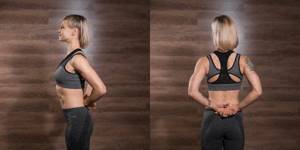
Place your hands behind your back, clasp your wrist with one hand and the other. Bend your elbows and lift your wrists higher. Push your chest forward and feel the stretch in the front of your shoulders.
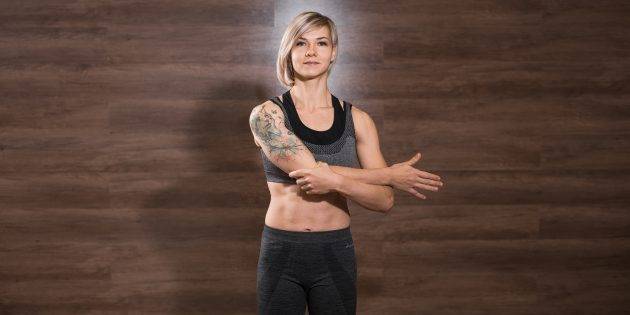
Grab your opposite elbow with your hand, press your shoulder towards you and pull it down. Repeat with the other hand.
Back Shoulder Stretch
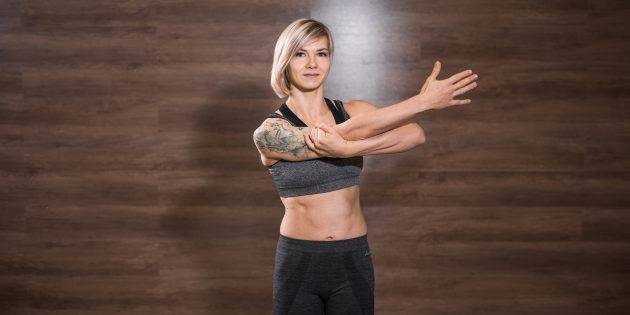
Grasp your right arm with your left above the elbow, press it to your body and straighten it, lower your right shoulder down. With your left hand, pull your right hand up, lifting it with your elbow. Feel the tension in the back of your shoulders.
Triceps stretch

Go to the wall, lift your left elbow up, and place your forearm behind your back. Lower your left shoulder blade down. To check that it has actually dropped and will not rise during the stretch, place your right hand below your left armpit.
Repeat on the other side.
Biceps stretch
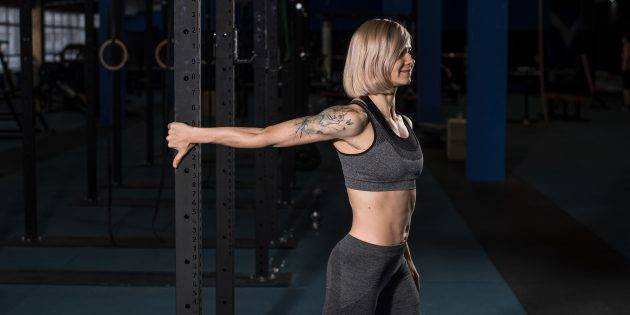
Grab a doorknob, counter, or other support and turn your back to it. Turn your elbow upward and move your body slightly forward.
Triceps and Shoulder Stretch
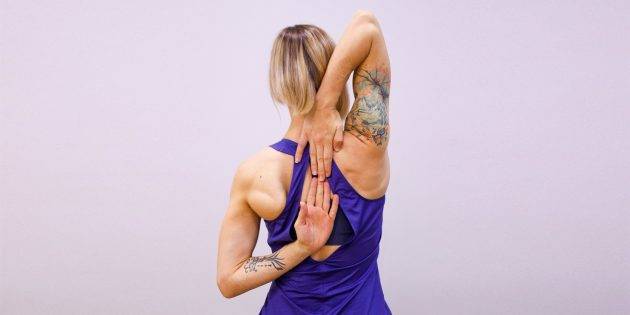
This pose allows you to simultaneously stretch the triceps of one arm and the front of the shoulder of the other. Place one hand behind your back from above so that your elbow points upward, and the other from below so that your elbow points to the floor. Try to bring your wrists together behind your back at the level of your shoulder blades.
Wrist Extensor Stretch
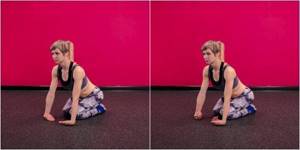
Sit on your knees, place your hands in front of you so that the backs of your hands touch the floor and your fingers are directed towards each other.
Gently shift your weight into your hands, stretching your forearms. To enhance the effect, try clenching your fists
Exercise therapy for the cervical spine
Stretching the spine at home can help with problems with the cervical spine and hypertension, and sets of exercises are recommended to begin and end with a massage.
You need to rub your hands with your palms so that they become warm, and begin to rub your head from the forehead to the back of the head, smoothing it with your fingers and kneading the neck muscles at the end.
I. p. - sitting on a chair, spine straightened.
- You need to raise both shoulders up, stretching your head and stretching the cervical vertebrae. Go back and do it again 5-10 times.
- You need to tilt your head forward all the way and also back, stretching the neck muscles and remaining in extreme positions for 5-10 seconds. When tilting your head back, you need to arch your spine, taking a deep breath. Returning back, exhale. Do this 5-10 times.
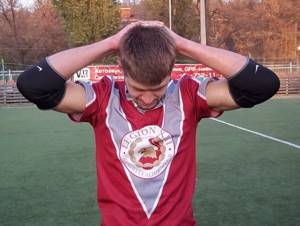
- Now you need to turn your head to the right and to the left, lingering in extreme positions for 5-10 seconds. This twisting movement helps improve the mobility of the cervical vertebrae.
- From a sitting position, with the spine straight, you need to move your head and chin forward, like a goose, fix it for 3-5 seconds, and return your head back. Do 5-10 times. This movement helps improve blood circulation in the brain and its function.
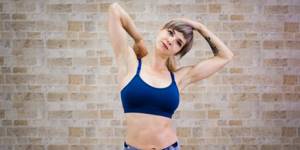
- From and. while sitting, place your right hand on your left shoulder, and turn your head to the right side, stay like that for 5-10 seconds, then return to i. n. Now do the same in the other direction. Do this 5-10 times. This movement works the lateral muscles of the neck and shoulders.
Conditions for stretching
Improper exercise can also cause complications or injuries to the spine. To prevent this from happening, you need to follow some rules.
- It is best to exercise in the afternoon or evening. In the morning, muscles and ligaments are less elastic, and it is more difficult to perform exercises. In addition, by the evening fatigue and tension accumulate, which means a good stretch will come in handy.
- It is not recommended to exercise on a full stomach. Firstly, it interferes with movements, causes a feeling of heaviness and discomfort, and secondly, it is very harmful to digestion. Between eating and stretching, at least 40 minutes should pass, or better yet, an hour and a half.
- The room where you plan to exercise should be well ventilated and free enough so that you do not touch furniture with your hands or feet when performing exercises.
- Each time you need to start with a warm-up to thoroughly warm up your muscles. To do this, you need to intensively move your arms, shoulders, bend your body and do several squats. To stretch the cervical vertebrae, turn your head in different directions, bend back and forth, and make circular movements.
- The number of repetitions should be increased gradually, starting from 3-4 times. If an exercise is difficult or doesn’t work out at all, give it up for a while and try again after 5-6 sessions, when the ligaments and muscles are a little stronger.
Well, the most important thing is that you cannot exercise forcefully, reluctantly, or in a bad mood. The emotional state significantly affects the effectiveness of exercises, so take a break from all your worries for a while and tune in to the positive
Prices for orthopedic sports shoes
Exercise therapy for the thoracic spine
I. page - I'm standing.
- Inhaling, you need to spread your arms to the sides and slightly back, palms up, slightly arching your back. Come back and do it again 5-10 times.
- From and. while inhaling, you need to raise your straight right arm forward to chest level, and your left arm back, while turning and looking to the left. In the extreme position, the arms are parallel to the floor. Go back and do the same thing in the other direction. Do this movement 5-10 times.
- Now from i. p. standing, inhaling, the right hand is pulled back with the palm up, and bend after the hand. Go back and do it on the other side. Do the movement 5-10 times.

- As you inhale, “spreading the clouds,” your arms rise up. As you exhale, they lower themselves to the sides with the spine bending backwards and stop in i. p. below. The movement is done 5-10 times.
- Inhaling, the right hand moves upward from the side (palm facing up, gaze directed upward), and the left hand is placed behind the back and the back is bent back. With an exhalation, the hands return back. The same is done on the other side. Perform the movement 5-10 times.
Exercises performed for intervertebral hernia
Among the therapeutic exercises, there are also those that are recommended for performing in case of herniated intervertebral discs. Stretching exercises are considered the best among them. After performing them, pain in the back decreases and the muscles relax. Such exercises can be roughly divided into the following types:
- Strength training is also stabilizing. These types of exercises can strengthen your back and abdominal muscles. At the same time, strength and endurance increase, and spinal mobility improves.
- Low intensity aerobic exercise. Among these activities, swimming stands out, followed by cycling and walking. Such exercises, without creating excessive tension for the muscles, will strengthen them both on the back and on the stomach. Water gymnastics is most beneficial because it reduces the impact of stress on the back.
- Yoga. Most complexes of such gymnastics allow you to increase the flexibility of the body, its physical fitness and psychophysical mood. The intensity and severity of lumbar pain decreases after performing a set of exercises.
- The most effective way to reduce back pain is stretching. By combining it with strength gymnastics, it is possible to achieve a significant effect.
https://youtube.com/watch?v=76ZGybx-fs8
To do this, you need to perform strengthening and general health exercises. However, if there are any diseases in the body, one should not forget about the need for preliminary consultation with a doctor.
Exercise therapy for the lower back
At home, it is advisable to do all therapeutic exercises for stretching the spine after warming up the muscles.
I. page - I'm standing.
1. You need to bend forward at the waist, trying to reach the floor with your hands. Then stop for 3-5 seconds and straighten up. Do 3-5 times.
I. p. - you need to sit on the floor.
2. You need to sit on the floor, legs together, and lean forward with a delay of 3-5 seconds. Then straighten back up and perform this movement 3-5 times.
3. I. p. the same: legs moved to the sides. It is necessary to lean forward again with a delay of 3-5 seconds. Straighten up and do 3-5 times.
I. p. - you need to lie on your stomach.
4. Hands are pulled up with your palms to your head and, leaning on them, you need to lift your body with your head, bending at the lower back. Stay in this position for 3-5 seconds, lower back, rest and do it again 3-5 times.
5. You need to do push-ups on your hands and arch your lower back at a right angle. Hold the position for 3-5 seconds, return to the floor, rest and perform again 3-5 times.
Stretching rules
For the training to be effective, you need to perform static stretching after strength training, this will relieve pain from all muscle groups. People suffering from scoliosis need to devote more time to stretching than others.
Many strength exercises should be diluted with stretching, such as squats.
For pain in the back, the exercises described above are suitable - “Cat” and “Camel”. You can perform these movements about 5 times during your workout. You shouldn’t stay in one position for a long time when stretching; everything should be done in moderation. There is no need to start strength exercises immediately after stretching, because... in this case, the result of stretching will be zero.
Back stretching using the Bubnovsky method
Spinal stretching at home should be selected taking into account solving problems in the part of the back where the source of the disease is located. The following exercises from Bubnovsky’s method help to work out the spine in the lumbar region.
I. p. - standing on all fours.
- Inhaling, bend your back and move your head back; exhaling, you need to bend over and tuck your head under you. Do it again 5-10 times.
- You need to lower your body to the floor, arching your back and moving your head up and back. Go back and do it again 5-10 times.
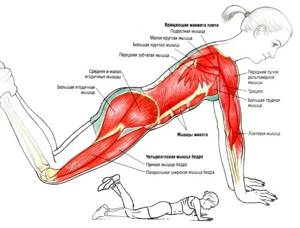
Spinal stretching exercises according to Bubnovsky are very effective for degenerative processes of the spine - While on your knees, you need to do push-ups from the floor about 5-10 times.
I. p. - you need to lie on your back.
- You need to bend your right leg at the knee and pull it towards your body with your arms. Do the same on the left leg. The movement is done 5-10 times.
- Now, as you inhale, both legs rise and are pulled towards the body with your arms. Exhale and come back. Perform the movement 5-10 times.
For what diseases is stretching the muscles of the back and spine indicated?
The human back is very vulnerable due to its vertical position, to maintain which the spine withstands colossal loads. The situation is significantly aggravated when carrying heavy loads, doing physical labor and lack of preventive sports.
Every person has complained of back pain at least once. Any person needs to perform a special set of exercises to compensate for the lack of physical activity.
Systematic training is especially necessary for the following groups of people::
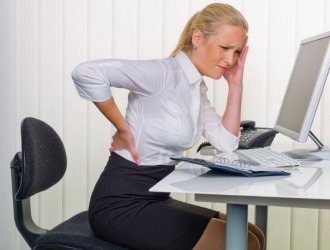
leading a sedentary lifestyle;- having a weakened muscular corset of the spinal column;
- with a constantly tense state of individual muscle groups;
- if there are various circulatory disorders;
- with incorrect posture;
- when diagnosing nutrient deficiency in intervertebral discs;
- if deformities of the spinal column are established;
- with existing pathologies of the spine, which are accompanied by intense pain.
Contraindications to back stretching
Despite the objective positive changes that are observed in people who regularly perform back stretching exercises , there are a number of contraindications for which such exercises are not recommended :
- for existing diseases, which include arthritis and osteoporosis;
- cardiovascular pathologies, especially if thrombosis is diagnosed;
- during viral and colds, if a person feels feverish.
People suffering from osteochondrosis can perform exercises with extreme caution..
Women during pregnancy are allowed to exercise, subject to consultation and supervision with a doctor and careful attention to their own feelings.
Video: “Back stretches and backbends”
Yoga for Spine Stretching
Yoga exercises, called asanas, help well in stretching the entire spine, and also correct posture if you practice this system regularly.
- The main yoga pose is Shavasana. You need to lie on your back, relax, with your hands palms up. You need to place your hands under the lower back and gradually begin to stretch the spine, moving your shoulder blades up and using your hands to pull your lower back down. Return to i. p. and relax, do 3-5 times.

- The fingers intertwine and rest behind the head on the back of the head. It is necessary to stretch the spine again, moving the lower back down and pulling the cervical vertebrae up with your hands. Do it 3-5 times.
- Vajrasana pose - sitting on the heels. You need to kneel down and then sit back on your heels. From this position, bend back, bending at the waist and throwing your head back, resting your hands on the floor behind you. Fix the position for 3-5 seconds and return back. This pose improves blood circulation in the lower back and lower limbs.
- Sukhasana - tailor's pose. You need to sit upright with your legs crossed and your spine straight. As you exhale, you need to lean your body forward and try to reach the floor, stretching your spine; your arms are also stretched forward as far as possible. Go back and rest, perform 3-5 times.
- Dandasana pose. You need to sit on the floor, legs straight, spine straight. As you exhale, bend your torso towards your legs and stop for 3-5 seconds. Go back and do it again 3-5 times. This asana restores blood circulation and relieves lower back pain.
Exercises with non-standard equipment
If you have a chest expander, fitball or rubber band (rubber loop) on hand, choose the appropriate one from the exercises presented. They will significantly diversify your load and allow you to work your muscles at a more natural angle. Suitable for both home and hall.
- Reduction of shoulder blades with a chest expander. A unique exercise that simultaneously works the rhomboid and latissimus dorsi muscles. It is considered one of the heaviest. It has the maximum natural amplitude for a person.
- Pull your own weight using a rubber band. A lightweight version of pull-ups and a complete analogue of the overhead pull-down.
- Horizontal pull-ups with a tourniquet. Analogous to the thrust of a horizontal block. One side of the tourniquet is tied to the battery (door handle, etc.), the further task is to sit on the floor and pull your body towards the projectile, completely raising your body and without bending your legs at the knee joint.
- Hyperextension on a fitball.
Back exercises for sedentary work
This complex does not require much effort to master and makes it possible to stretch the back muscles and relieve pain in the spinal column.
I. p. - sit on a chair, hands on your knees.
- It is necessary to raise and lower your shoulders to loosen the neck and shoulder muscles and restore blood circulation. Do 5-10 times.
- Now you need to bend your back and move your head back, straightening and stretching your spine. Repeat 5-10 more times.
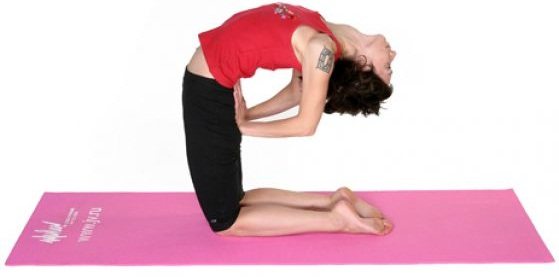
- Inhaling, bend back and throw your head back. Exhaling, bend your torso toward your knees, stretching your back, grabbing your ankles with your hands. Do 3-5 times.
- When sitting in a chair, you need to move closer to its back. During inhalation, the arms are raised and spread to the sides, palms up. While exhaling, you need to go back and then do it 3-5 times.
- Now, exhaling, tilt your head to your right shoulder, lowering your shoulder with your hand, and raising your left hand with your shoulder. As you inhale, go back and do the same in the opposite direction. Do 3-5 times.
Exercise during working hours
Often people who have sedentary work have tension in the lumbar spine. In order to eliminate it, there are special stretching complexes that can be performed right at the workplace.
Stretching the lumbar region is performed quickly, but quite effectively. To do this, you should get up from the chair, straighten your back and bend it back as much as possible. Then return to the starting position and repeat the exercise again.
Another stretch is to stand near a support or wall, lean your hands on it and try to bend your lower back.
How to stretch your back with osteochondrosis
As a rule, osteochondrosis affects cartilage tissue. When performing gymnastics, you need to move from simple to complex and perform simple exercises until the exacerbation passes and the pain subsides.
I. p. - sit on a chair.
- Hands are on your hips. As you inhale, you need to bend your back, bringing your shoulder blades together. Fix the position for 3-5 seconds, go back and do it again 5-6 times
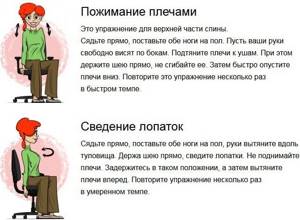
- You need to place your hands on your hips and make circle movements with your shoulder blades and shoulders back 5-10 times. Relax and do it again the same number of times.
I. p. - you need to sit on your back.
- Your arms should be spread to the sides and your legs should be tucked towards your chest. From this position, the legs are retracted to one side, and the head is retracted in the opposite direction: a twist is obtained. This position needs to be fixed for 3-5 seconds, come back and do it in the other direction. This movement is done 3-5 times.
- You need to sit on the floor and straighten your legs. Then bend forward and try to reach your toes with your hands, holding for 3-5 seconds. Straighten up, rest and do 3-5 times.
- You need to stand with your hands at your sides, then bend forward, trying to touch the floor with your hands, look straight ahead, fix the pose for 3-5 seconds. Straighten up and do it again 3-5 times.
Best Lower Back Stretches
Decades of research into the effectiveness of yoga for lower back pain have led to one fairly simple conclusion: the easiest way to eliminate back pain (and keep it from coming back) is through stretching.
Because people with chronic problems in the lower spine have long noticed that their disease disappears in just 20 minutes of yoga if they do it every day. The researchers also recommend that if you spend a lot of time sitting, stretching your back for just 60 seconds every 20 minutes of sitting can significantly improve the health of your lower spine.
For those who spend a lot of time standing, it is advisable to add hamstring stretches. This significantly reduces tension in the lower back. In a nutshell, the less stiff the muscles in your back, hips and legs are, the better your lower back will feel . It should also be mentioned that the absence of excess weight plays an additional role. Research shows that there is a clear relationship between obesity and low back pain . The heavier the upper body, the greater the load on the lower spine.
So, let's move on to the exercises.
By the way, there is no need to do all these exercises every day. It's best to try each of them, but choose 3 or 4 that work best to relax your back. And try to do them every day. Here, for example, are the 4 most popular of them: two-knee pendulum, pigeon, “thread into a needle,” sitting crunches.
1. Pendulum with two knees.

2. Cobra.
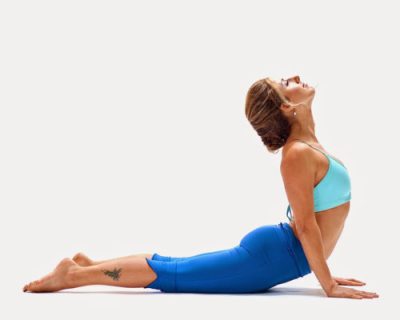
3. Seated crunches.
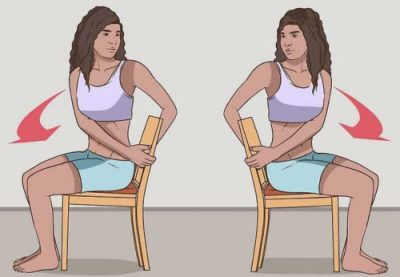
This exercise is great when you're traveling in a car or plane and want to prevent lower back spasms. Holding the seat armrest with your left hand and keeping your back straight, turn the right side of your body towards the armrest and maintain this position for 1 minute. Then do the same in the other direction. Note: For bonus points, try to get your right elbow to go beyond your left leg and vice versa.
4. Pigeon.
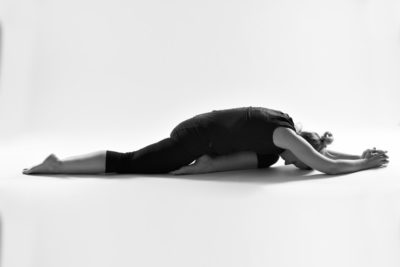
5. Legs up along the wall.
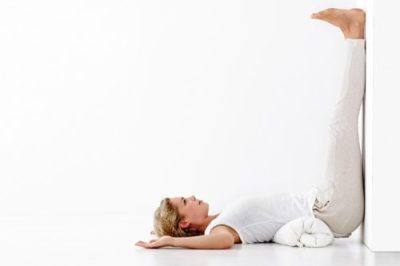
Lie on the floor, perpendicular to the wall so that your buttocks rest against it. Raise your legs, straighten them and lean your elbows on the wall. Feel the relaxation in your lower back and upper thighs. For comfort, you can bend your knees and ankles, and place a small pillow or rolled blanket under your lumbar spine.
Stay in this position for 5-7 minutes.
6. Hamstring stretch.
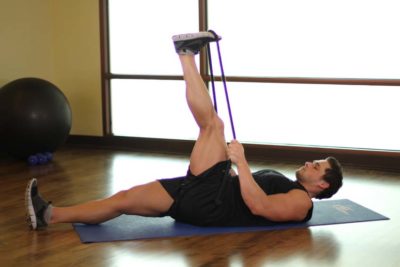
7. "Thread the Needle".
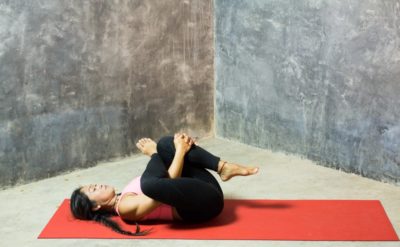
For scoliosis
I. p. - sit on a chair.
- The movement is performed with light dumbbells. While inhaling, you need to move your arms to the sides and bring your shoulder blades together, fix the position for 3-5 seconds, and return back. Do 5-6 times.
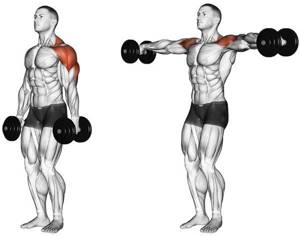
- Now, while inhaling, you need to raise your hands with dumbbells up, bending a little, and stop for 3-5 seconds. Go back and do it again 5-6 times.
I. p. - you need to sit on your stomach, hands at your sides.
- Inhaling, you need to lift your body and head up, your arms rise a little back and up to bring your shoulder blades together. You need to stay in this position for 3-5 seconds, then return and relax. Do it again 3-5 times.
- The same pose, just bend your elbows and place your palms near your face. Inhaling, rise up and lift your torso and arms off the floor, bringing your shoulder blades together. Stay for 3-5 seconds, go back and rest. Do it 3-5 times.
- Now from i. etc., you need to alternately raise your left and then your right leg. Do 3-5 times.
For herniated discs
Spinal stretching at home relieves pain from a hernia between the vertebrae, which squeezes or displaces the intervertebral disc beyond the fibrous ring. The disc puts pressure on nearby muscles and nerves, causing pain. There are a number of gymnastics movements to train muscles and relieve pain.
- I. p. - you need to stand up and clasp your hands together. Moving your hands up, you need to move them behind your head and stretch, rising on your toes. If you linger, come back and do it several times.

- Now you need to bend down and reach the floor with your fingers, rising on your toes and stretching forward behind your arms. Hold for 2-3 seconds and roll from your toes to your heels. Go back, rest and do this movement again 2-3 times.
- I. p. - stand up straight. You need to lean down and rest your hands on the floor. After this, bend down in an arc and return to your previous position. Do it 2-3 times.
- I. p. - position yourself on your back, place your arms along your body. You need to rise to the top with your body, while using your fingers to help yourself in the lumbar region. After making 2-3 movements, come back and relax. If it is difficult to perform with straight legs, then you can bend them at the knees, moving the heels closer to the buttocks. Do 3-5 times.
- You need to lie on your back, place the palm of one hand on the other and stretch them behind your head. Now, pulling the socks on your feet towards you, you need to try to stretch your spine and stretch out. Make the same effort by stretching your toes in the opposite direction. Do this 3-5 times.
Comprehensive treatment to prevent disease
Back pain after a working day is familiar to many people. As a rule, they try to remove it with the help of various gels or ointments, which is initially wrong. Since the deformation of the intervertebral discs is not removed, but only pain symptoms are relieved, which tend to quickly return after the end of the action of the remedy or the performance of work duties. Only daily stretching for the spine and back in the morning can help remove the root cause of the unpleasant symptom and prevent its occurrence in the future.
These activities will be beneficial for osteoporosis, spondylosis, radiculitis, narrowing of the spinal canal, and hernia of the lumbar spine. So, when there are no contraindications (diseases in the acute stage, pregnancy, high temperature), then you can do exercises to stretch the spine and back.
Exercises for the lumbar region
Gymnastics for the lower back is carried out as follows:
- To perform this exercise, you will need a horizontal bar, which you will need to climb onto, hooking your feet on the bar and hanging down. At first, it is advisable to have a partner who can help and support you as a backup. You need to hang on the horizontal bar for approximately one minute. In total, you need to do at least four approaches at one time.
- It is possible to develop back muscle tissue in this way: lie on your back, legs bent at the knees, hug them with your arms and pull them to your stomach.
- You need to lie on your back, legs bent at the knees, and feet on the floor, spread apart shoulder-width apart. In this position, you need to inhale as much as possible, completely drawing air into your chest, and exhale, holding your breath for 8–9 seconds. Number of executions – 6–12 times.
- It’s also a good idea to do an exercise called the “snail.” To perform it, you need to lie on your stomach, rest your hands on the floor and try to reach the crown of your head with the tips of your toes.
- You need to lie on your stomach, stretch your arms along your body and try to lift your legs and head at the same time, fixing them in this state for a couple of seconds.
Exercises for the thoracic and cervical spine
The exercises are as follows:
- Tilts of the head back and forth, from side to side can help strengthen the cervical spine and stretch it, relieving tightness and a feeling of stiffness in this part of the body.
- To strengthen the spinal cervical and thoracic spine, you need to stand straight, with your feet shoulder-width apart, and try to turn your head as far back as possible, fixing your torso in this position for a couple of seconds. This must be done alternately on the left and right sides.
Working with a load
Stretching the back and spine at home is possible using a weight. To do this, you need to sew a special belt with reliable cords on both sides, where the weights will be attached.
You need to lie down on the sofa in a special belt and attach a weight to it, which should hang from the sofa and enhance the stretch. The weight of the load that is selected must be at least 2 kilograms and must be the same on both sides.
While at the computer, you can be distracted for a short time, stretch your arms forward, joining them in a lock, and maintain this position for 15 seconds. This will make it possible to remove tension from the thoracic and cervical spine. You can perform the exercise in a standing position, stretching your arms as far as possible to the top. In turn, you can put your hands behind your shoulders or throw them behind your head, spreading your shoulders back all the way.
Yoga classes are great for stretching the spine. This type of exercise has a complex of “asanas”, which is aimed at gradually relaxing and strengthening the spinal muscles, stretching the spine, improving the functioning of internal organs and respiratory function.
Exercises for stretching the back muscles and spine are an effective way to prevent many diseases, including herniated discs, radiculitis and osteochondrosis. There is no need to wait until these diagnoses are indicated in your medical record. Strengthening and stretching the muscles of the back and spine can be started at any time, and the sooner you start doing this, the better.
In addition, by doing exercises to stretch the back muscles and spine, you can reduce your weight. Since when stretching, the work of the lymphatic system is activated, and it, among other things, helps to actively transport fat throughout the body, thereby increasing its overall consumption. That is, stretching for the back and spine will not only improve your health, but will also help normalize your weight.
Contraindications
When performing traction and any therapeutic exercises, there are general contraindications that you need to know and adhere to:
- disorders of the circulatory system (hypertension, arrhythmia);
- serious spinal injury;
- damage to bone tissue;
- pregnancy period;

- oncological diseases;
- epilepsy;
- skin and infectious diseases in the acute stage;
- diseases of organs inside the body in the acute stage;
- high body temperature;
- serious mental illness.
Possible consequences and complications of gymnastics
Possible complications after therapeutic exercises may arise due to excessive zeal during its implementation or when it is performed in a stressful and overstrained state.
In order not to worsen the disease, you need to know the following rules:
- increased pain after performing therapeutic exercises (incorrect or difficult exercises were chosen);
- muscle spasms and sprains from excessive strain and fatigue;
- worsening of the disease with the wrong choice of traction methods;
- deterioration in general health and increase in temperature when the patient conceals serious pathological illnesses from the doctor.
People with serious spinal diseases sometimes lose hope of recovery after years of treatment with medications. But with the development of medicine, new herbal preparations, exercise equipment and manual treatment methods appear.
Stretching the spine using exercise machines and gymnastic complexes at home in combination with traditional medicine gives people hope for recovery and relief from diseases.
Article design: Mila Friedan
Advantages and benefits of this complex
- This complex of exercise therapy for the back includes movements borrowed from the practice of yoga. They are an excellent way to bring all body systems into a state of harmony.
- It is not recommended to include active exercises in morning exercises, since the body has not yet fully woken up. This complex provides a gentle load and at the same time promotes thorough muscle development and stretching.
- To overcome a sedentary lifestyle, it is recommended to follow this system. It does not take much time, is performed without significant stress, and at the same time heals the body and charges you with a good mood.
- Selection of movements. From the entire morning complex, you can choose from three to five exercises that are most suitable for you and perform them. After doing morning exercises, you feel cheerful and pleasant sensations in your muscles and throughout your body.
An indicator that you have correctly followed the technique of performing morning exercises will be a pleasant sensation in your muscles and vigor. Morning exercises are necessary for everyone - both those who have active physical work and those who lead a sedentary lifestyle. Without physical activity, unfavorable changes occur in the body: this concerns the cardiovascular and respiratory systems, the musculoskeletal system, and the functioning of internal organs.
Attention! If for some reason you did not have time to complete the complex in the morning, you can perform it in the evening. The only condition is that two and a half hours must pass after eating.
